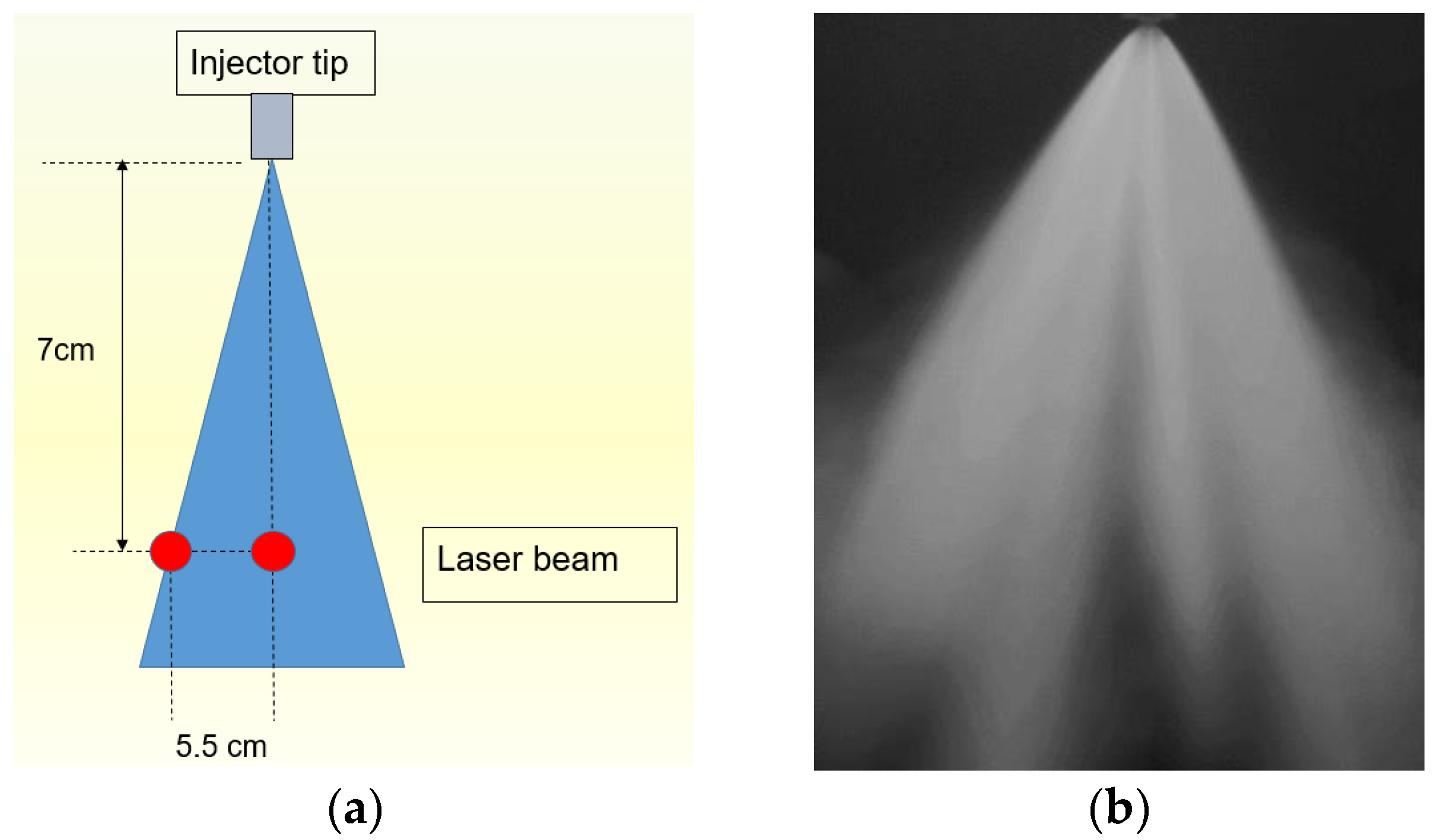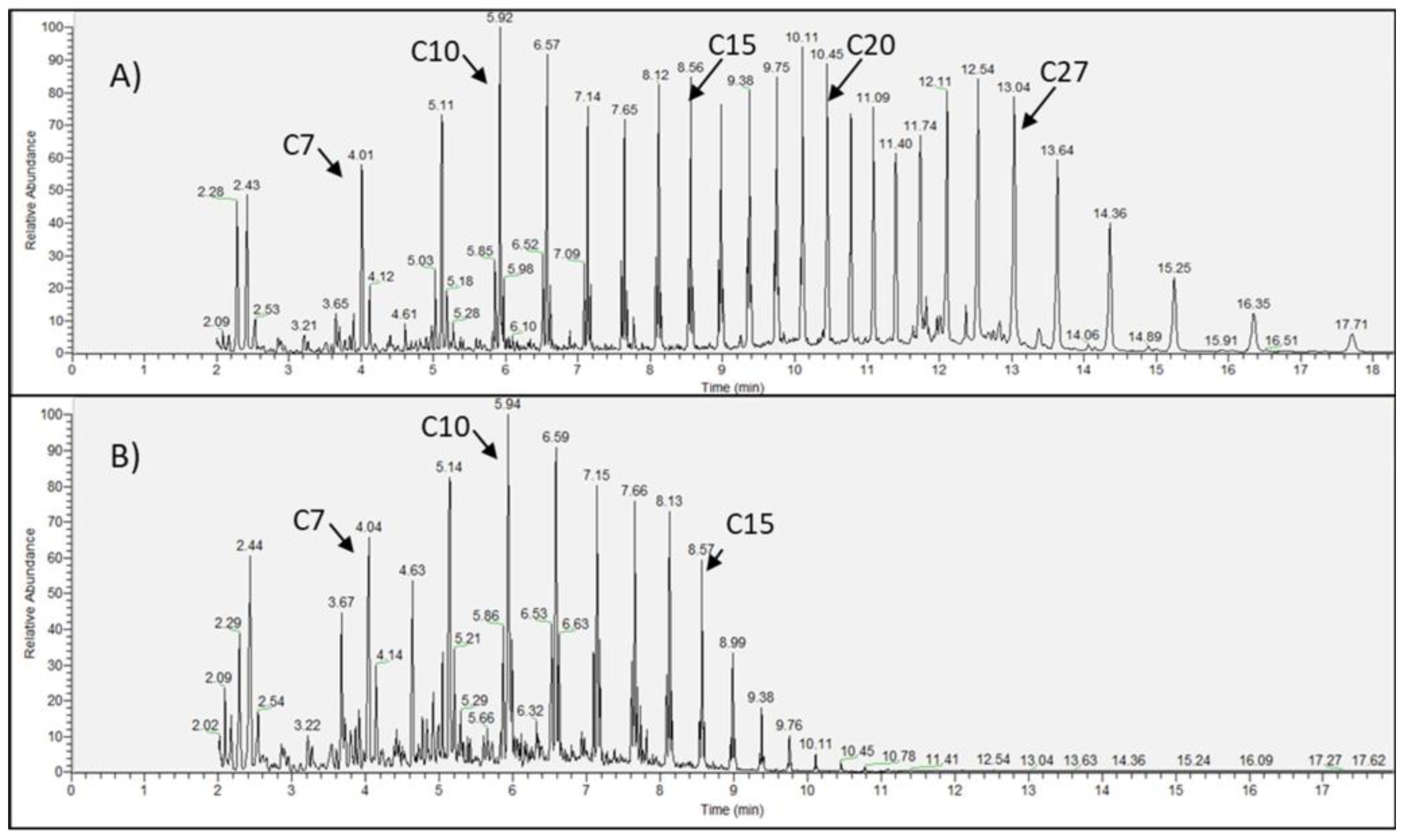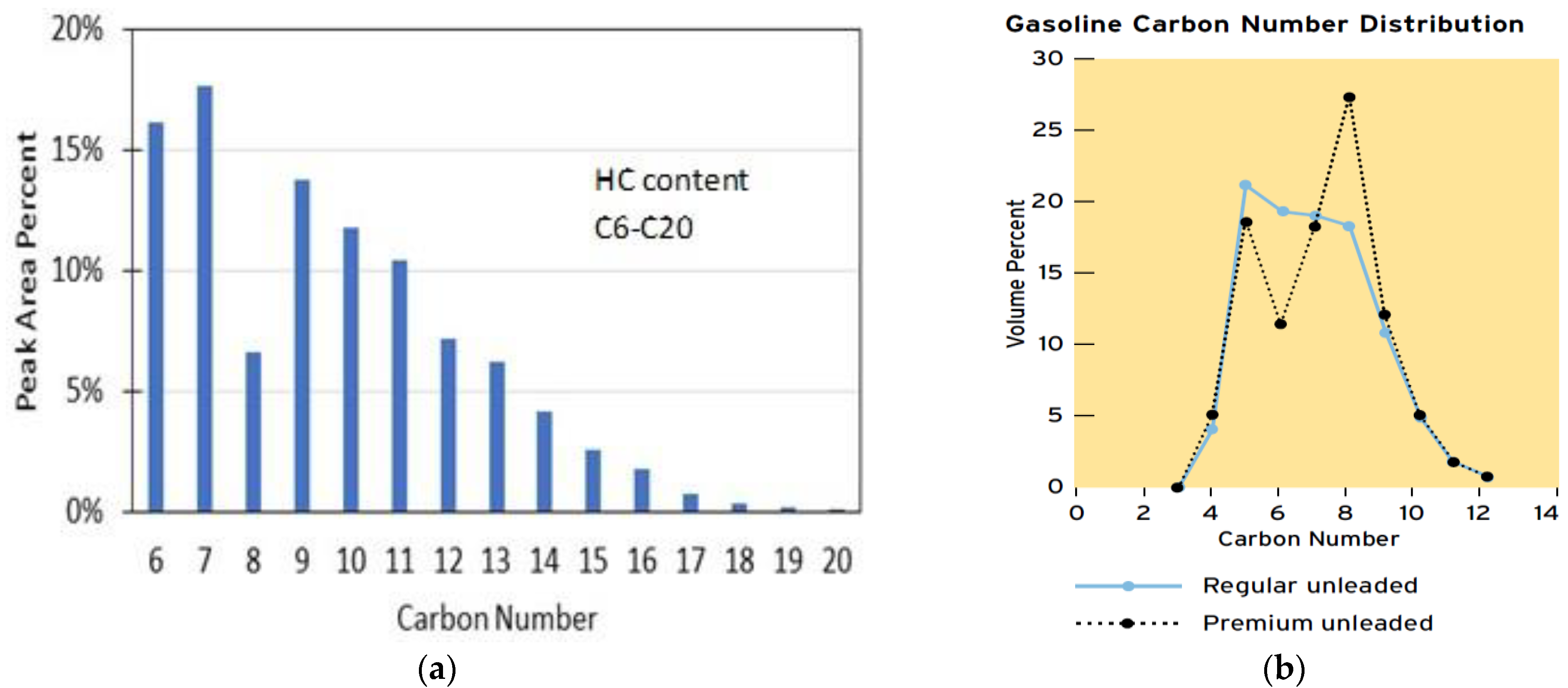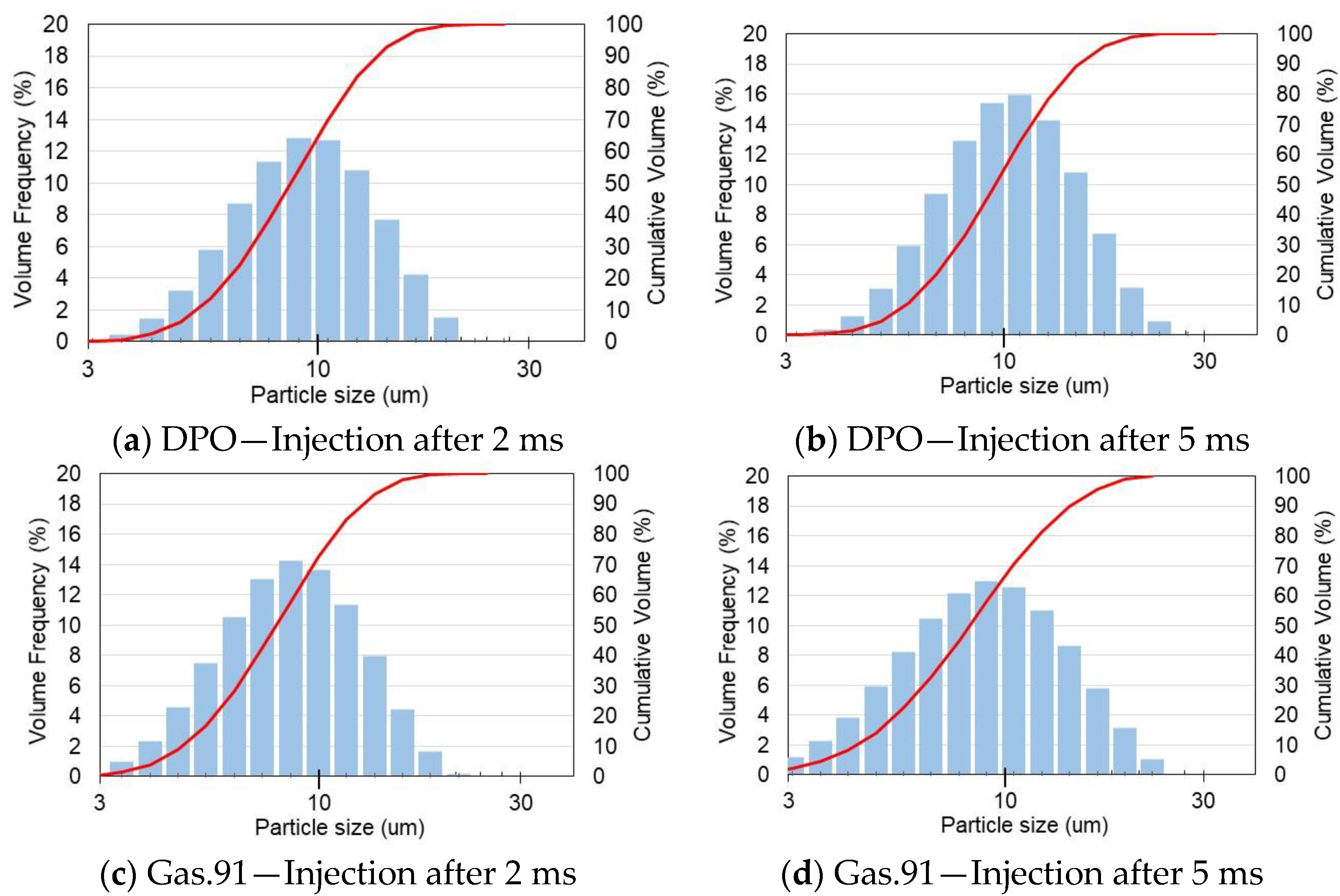Comparative Analysis of Injection of Pyrolysis Oil from Plastics and Gasoline into the Engine Cylinder and Atomization by a Direct High-Pressure Injector
Abstract
:1. Introduction
2. Materials and Methods
2.1. Technology for Pyrolysis Oil Formation
2.2. Methods for Gas Chromatography–Mass Spectrometry (GC/MS)
2.3. Spray Analysis
- In the middle of the injected jet;
- At the edge of the jet.
2.4. Uncertainty and Repeatability of Spraying Tests
3. Results
3.1. Results from Chemical Analysis
3.2. Results from Spraying Tests
4. Discussion
5. Conclusions
- Waste plastics consisting of HDPE can be applied as a feedstock for the pyrolysis process with its main objective being to produce pyrolysis oil.
- The distillation process successfully removed heavier hydrocarbons and makes the pyrolysis oil in carbon number distribution for gasoline-fueled engines, either spark-ignited or GCI engines. Finally, the hydrocarbons C15–C30 were significantly reduced after the distillation.
- The Sauter Mean Diameter can be considered the parameter that can reliably characterize the spraying and atomization of distilled pyrolysis oil.
- The SMDs for 91-RON gasoline and DPO were found to be similar to each other, hence, a direct gasoline injection strategy can be implemented. However, as tested, the SMD for DPO was found to be on average 1 µm larger than that of the 91-RON gasoline.
- Due to the high content of C11–C15 compounds that can promote easier self-ignition, DPO from HDPE pyrolysis can be considered a single fuel or a potential additive for blending the gasoline 91 to form a highly reactive fuel for the compression-ignition strategy in the reciprocating engine.
- Regarding the injection process, there are no remarkable drawbacks to applying DPO as a substitute fuel for direct injection into the internal combustion engine.
Author Contributions
Funding
Data Availability Statement
Acknowledgments
Conflicts of Interest
Abbreviations
| CI | compression ignition |
| CO | carbon monoxide |
| CR | compression ratio |
| DCM | dichloromethane |
| DPO | distilled pyrolysis oil |
| GCI | gasoline compression ignition |
| GC/MS | Gas Chromatography—Mass Spectrometry |
| HC | hydrocarbons |
| HDPE | high-density polyethylene |
| NOx | nitric oxides |
| RON | research octane number |
| SI | spark ignition |
| SMD | Sauter mean diameter |
| STD | standard deviation |
References
- Chaudhari, U.S.; Lin, Y.; Thompson, V.S.; Handler, R.M.; Pearce, J.M.; Caneba, G.; Muhuri, P.; Watkins, D.; Shonnard, D.R. Systems Analysis Approach to Polyethylene Terephthalate and Olefin Plastics Supply Chains in the Circular Economy: A Review of Data Sets and Models. ACS Sustain. Chem. Eng. 2021, 9, 7403–7421. [Google Scholar] [CrossRef]
- Costa, G.A.; Santos, R.G. dos Fractionation of Tire Pyrolysis Oil into a Light Fuel Fraction by Steam Distillation. Fuel 2019, 241, 558–563. [Google Scholar] [CrossRef]
- Kumar, R.; Mishra, M.K.; Singh, S.K.; Kumar, A. Experimental Evaluation of Waste Plastic Oil and Its Blends on a Single Cylinder Diesel Engine. J. Mech. Sci. Technol. 2016, 30, 4781–4789. [Google Scholar] [CrossRef]
- Hürdoğan, E.; Ozalp, C.; Kara, O.; Ozcanli, M. Experimental Investigation on Performance and Emission Characteristics of Waste Tire Pyrolysis Oil–Diesel Blends in a Diesel Engine. Int. J. Hydrogen Energy 2017, 42, 23373–23378. [Google Scholar] [CrossRef]
- Tudu, K.; Murugan, S.; Patel, S.K. Effect of Tyre Derived Oil-Diesel Blend on the Combustion and Emissions Characteristics in a Compression Ignition Engine with Internal Jet Piston Geometry. Fuel 2016, 184, 89–99. [Google Scholar] [CrossRef]
- Umeki, E.R.; de Oliveira, C.F.; Torres, R.B.; dos Santos, R.G. Physico-Chemistry Properties of Fuel Blends Composed of Diesel and Tire Pyrolysis Oil. Fuel 2016, 185, 236–242. [Google Scholar] [CrossRef]
- Fu, P.; Bai, X.; Yi, W.; Li, Z.; Li, Y.; Wang, L. Assessment on Performance, Combustion and Emission Characteristics of Diesel Engine Fuelled with Corn Stalk Pyrolysis Bio-Oil/Diesel Emulsions with Ce0.7Zr0.3O2 Nanoadditive. Fuel Process. Technol. 2017, 167, 474–483. [Google Scholar] [CrossRef]
- Koc, A.B.; Abdullah, M. Performance of a 4-Cylinder Diesel Engine Running on Tire Oil–Biodiesel–Diesel Blend. Fuel Process. Technol. 2014, 118, 264–269. [Google Scholar] [CrossRef]
- Martínez, J.D.; Rodríguez-Fernández, J.; Sánchez-Valdepeñas, J.; Murillo, R.; García, T. Performance and Emissions of an Automotive Diesel Engine Using a Tire Pyrolysis Liquid Blend. Fuel 2014, 115, 490–499. [Google Scholar] [CrossRef]
- Karagoz, M.; Uysal, C.; Agbulut, U.; Saridemir, S. Energy, Exergy, Economic and Sustainability Assessments of a Compression Ignition Diesel Engine Fueled with Tire Pyrolytic Oil−diesel Blends. J. Clean. Prod. 2020, 264, 121724. [Google Scholar] [CrossRef]
- Murugan, S.; Ramaswamy, M.C.; Nagarajan, G. Assessment of Pyrolysis Oil as an Energy Source for Diesel Engines. Fuel Process. Technol. 2009, 90, 67–74. [Google Scholar] [CrossRef]
- Karagöz, M.; Ağbulut, Ü.; Sarıdemir, S. Waste to Energy: Production of Waste Tire Pyrolysis Oil and Comprehensive Analysis of Its Usability in Diesel Engines. Fuel 2020, 275, 117844. [Google Scholar] [CrossRef]
- Vihar, R.; Baškovič, U.Ž; Seljak, T.; Katrašnik, T. Combustion and Emission Formation Phenomena of Tire Pyrolysis Oil in a Common Rail Diesel Engine. Energy Convers. Manag. 2017, 149, 706–721. [Google Scholar] [CrossRef] [Green Version]
- Kumar, K.V.; Puli, R.K. Effects of Waste Plastic Oil Blends on a Multi Cylinder Spark Ignition Engine. MATEC Web Conf. 2017, 108, 08005. [Google Scholar] [CrossRef]
- Efendy, M.S.; Kamarrudin, N.S. Pyrolysis of Plastic Waste as an Alternative Fuels in Spark Ignition Engine. Int. J. Emerg. Trends Eng. Res. 2019, 7, 454–459. [Google Scholar] [CrossRef]
- Kareddula, V.K.; Puli, R.K. Influence of Plastic Oil with Ethanol Gasoline Blending on Multi Cylinder Spark Ignition Engine. Alex. Eng. J. 2018, 57, 2585–2589. [Google Scholar] [CrossRef]
- Szwaja, M.; Chwist, M.; Szwaja, S.; Juknelevičius, R. Impact of Pyrolysis Oil Addition to Ethanol on Combustion in the Internal Combustion Spark Ignition Engine. Clean Technol. 2021, 3, 450–461. [Google Scholar] [CrossRef]
- Zyada, A.; Zoldak, P.; Naber, J. Development of Multiple Injection Strategy for Gasoline Compression Ignition High Performance and Low Emissions in a Light Duty Engine. SAE Tech. Pap. 2022. [Google Scholar] [CrossRef]
- Zhang, J.; Tang, M.; Atkinson, W.; Schmidt, H.; Lee, S.Y.; Naber, J.; Tzanetakis, T.; Sim, J. Experimental Investigation of the Compression Ignition Process of High Reactivity Gasoline Fuels and E10 Certification Gasoline Using a High-Pressure Direct Injection Gasoline Injector. SAE Tech. Pap. 2020. [Google Scholar] [CrossRef]
- Martinez, G.L.; Poursadegh, F.; Magnotti, G.M.; Matusik, K.E.; Duke, D.J.; Knox, B.W.; Kastengren, A.L.; Powell, C.F.; Genzale, C.L. Measurement of Sauter Mean Diameter in Diesel Sprays Using a Scattering–Absorption Measurement Ratio Technique. Int. J. Engine Res. 2019, 20, 6–17. [Google Scholar] [CrossRef]
- Chen, L.; Liu, Z.; Sun, P.; Huo, W. Formulation of a Fuel Spray SMD Model at Atmospheric Pressure Using Design of Experiments (DoE). Fuel 2015, 153, 355–360. [Google Scholar] [CrossRef]
- Altaher, M.; Li, H.; Andrews, G. Influence of Residence Time on Fuel Spray Sauter Mean Diameter (SMD) and Emissions Using Biodiesel and Its Blends in a Low NOx Gas Turbine Combustor. In Proceedings of the ASME Turbo Expo 2016, Power for Land, Sea and Air, ASME 2016 Turbo Expo, Turbomachinery Technical Conference & Exposition, Seoul, Republic of Korea, 13–17 June 2016. [Google Scholar]
- Park, J.; Lee, K.H.; Park, S. Comprehensive Spray Characteristics of Water in Port Fuel Injection Injector. Energies 2020, 13, 396. [Google Scholar] [CrossRef] [Green Version]
- Zhou, L.; Shao, A.; Wei, H.; Chen, X. Sensitivity Analysis of Heavy Fuel Oil Spray and Combustion under Low-Speed Marine Engine-Like Conditions. Energies 2017, 10, 1223. [Google Scholar] [CrossRef] [Green Version]
- Tzanetakis, T.; Johnson, J.; Schmidt, H.; Atkinson, W.; Naber, J. Non-Reacting Spray Characteristics of Gasoline and Diesel with a Heavy-Duty Single-Hole Injector. Front. Mech. Eng. 2022, 8, 27. [Google Scholar] [CrossRef]
- Park, J.-W.; Jouzdani, S.; Tzanetakis, T.; Schmidt, H.; Atkinson, W.; Naber, J.; Pei, Y.; Tao, F.; Garg, R.; Langenderfer, D.; et al. Experimental Diesel Spray Characterization of the Medium-Duty Injector with Single- and Multi-Hole Nozzle Configurations under Non-Reacting, Non-Vaporizing Conditions. Front. Mech. Eng. 2022, 0, 81. [Google Scholar] [CrossRef]
- Kulas, D.G.; Zolghadr, A.; Shonnard, D.R. Liquid-Fed Waste Plastic Pyrolysis Pilot Plant: Effect of Reactor Volume on Product Yields. J. Anal. Appl. Pyrolysis 2022, 166, 105601. [Google Scholar] [CrossRef]
- Byrne, E.; Schaerer, L.G.; Kulas, D.G.; Ankathi, S.K.; Putman, L.I.; Codere, K.R.; Schum, S.K.; Shonnard, D.R.; Techtmann, S.M. Pyrolysis-Aided Microbial Biodegradation of High-Density Polyethylene Plastic by Environmental Inocula Enrichment Cultures. ACS Sustain. Chem. Eng. 2022, 10, 2022–2033. [Google Scholar] [CrossRef]
- Zolghadr, A.; Kulas, D.; Shonnard, D. Evaluation of Pyrolysis Wax as a Solvent in Polyolefin Pyrolysis Processing. Ind. Eng. Chem. Res. 2022, 61, 11080–11088. [Google Scholar] [CrossRef]
- Malvern Panalytical. Spraytec. Spray Droplet Size Measurement System. Available online: https://www.malvernpanalytical.com/en/products/product-range/spraytec?campaignid=59289900&adgroupid=1942201140&creative=302635385452&keyword=%2Bspraytec&matchtype=b&network=g&device=c&pk_campaign=59289900&pk_adgroupid=1942201140&pk_kwd=%2Bspraytec&pk_source=google&pk_medium=cpc&pk_content=302635385452&gclid=Cj0KCQiA14WdBhD8ARIsANao07jY7_ZlJ6ux-Ii_Iv4dUt7mlF_H7IfnLQ67gaE-1GbGDMqiRk16RXQaAg0WEALw_wcB (accessed on 20 December 2022).
- Gibss, L.; Anderson, B.; Barnes, K.; Engeler, G.; Freel, J.; Horn, J.; Ingham, M.; Kohler, D.; Lesnini, D.; MacArthur, R.; et al. Motor Gasolines Technical Review; Chevron Corporation: San Ramon, CA, USA, 2009. [Google Scholar]
- Lefebvre, A.; McDonell, V.G. Atomization and Sprays; CRC Press Taylor & Francis Group: New York, NY, USA, 2017. [Google Scholar]







Disclaimer/Publisher’s Note: The statements, opinions and data contained in all publications are solely those of the individual author(s) and contributor(s) and not of MDPI and/or the editor(s). MDPI and/or the editor(s) disclaim responsibility for any injury to people or property resulting from any ideas, methods, instructions or products referred to in the content. |
© 2022 by the authors. Licensee MDPI, Basel, Switzerland. This article is an open access article distributed under the terms and conditions of the Creative Commons Attribution (CC BY) license (https://creativecommons.org/licenses/by/4.0/).
Share and Cite
Szwaja, M.; Naber, J.D.; Shonnard, D.; Kulas, D.; Zolghadr, A.; Szwaja, S. Comparative Analysis of Injection of Pyrolysis Oil from Plastics and Gasoline into the Engine Cylinder and Atomization by a Direct High-Pressure Injector. Energies 2023, 16, 420. https://doi.org/10.3390/en16010420
Szwaja M, Naber JD, Shonnard D, Kulas D, Zolghadr A, Szwaja S. Comparative Analysis of Injection of Pyrolysis Oil from Plastics and Gasoline into the Engine Cylinder and Atomization by a Direct High-Pressure Injector. Energies. 2023; 16(1):420. https://doi.org/10.3390/en16010420
Chicago/Turabian StyleSzwaja, Magdalena, Jeffrey D. Naber, David Shonnard, Daniel Kulas, Ali Zolghadr, and Stanislaw Szwaja. 2023. "Comparative Analysis of Injection of Pyrolysis Oil from Plastics and Gasoline into the Engine Cylinder and Atomization by a Direct High-Pressure Injector" Energies 16, no. 1: 420. https://doi.org/10.3390/en16010420







